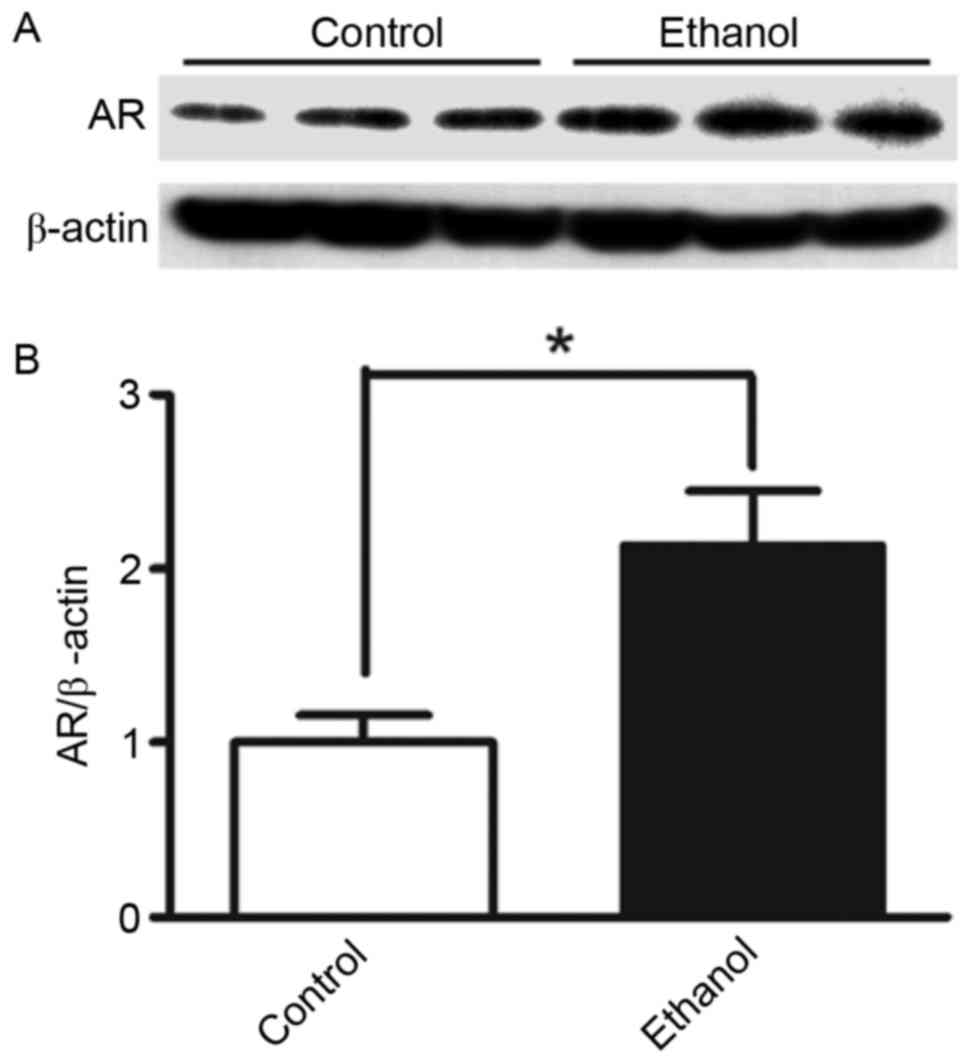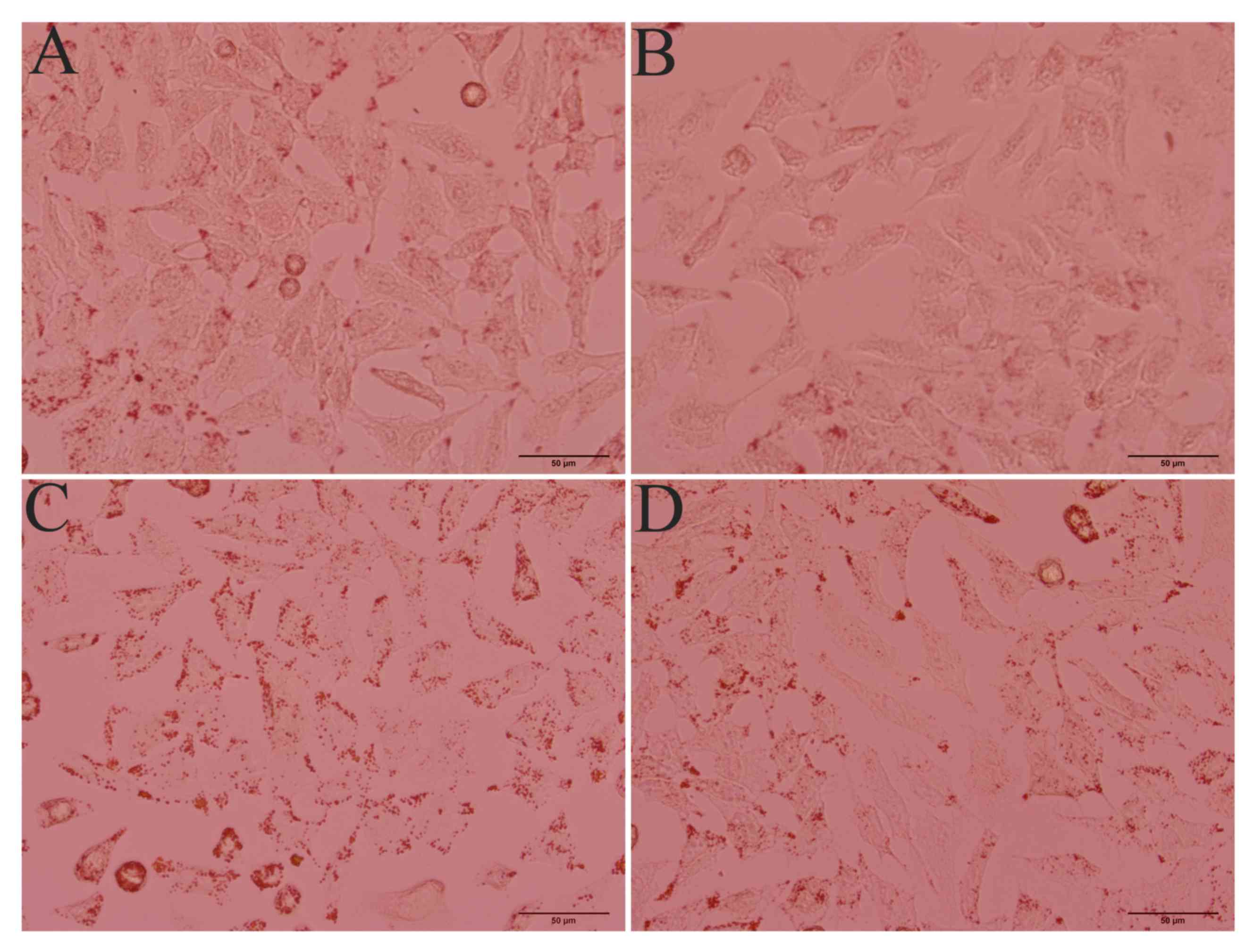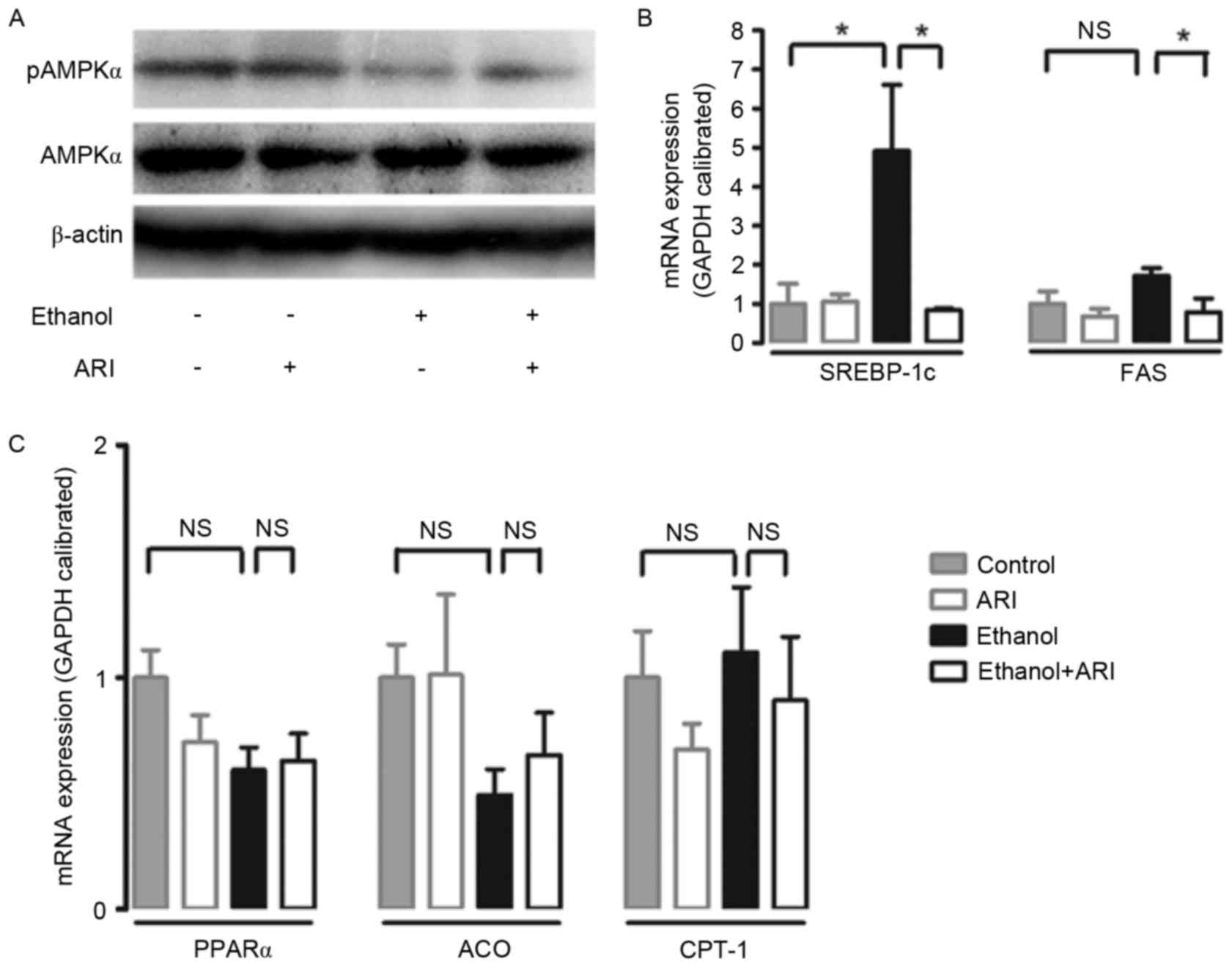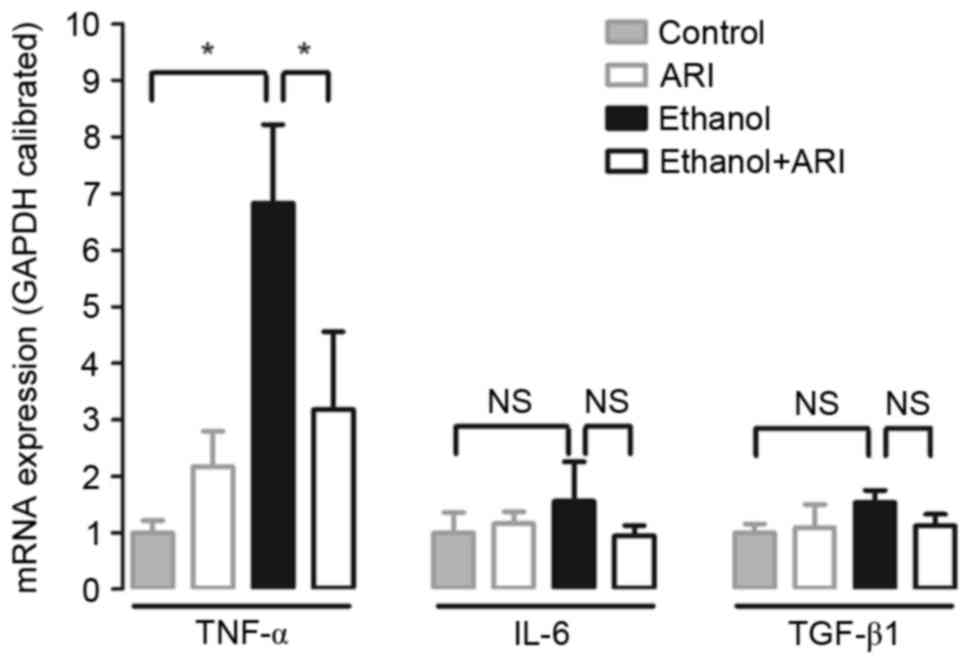Inhibition of aldose reductase ameliorates ethanol‑induced steatosis in HepG2 cells
- Authors:
- Published online on: March 10, 2017 https://doi.org/10.3892/mmr.2017.6313
- Pages: 2732-2736
Abstract
Introduction
Aldose reductase (AR; EC.1.1.1.21) belongs to the reduced coenzyme II-dependent aldo-keto reductase superfamily and it is the first enzyme in the polyol pathway of glucose metabolism (1). AR catalyzes the conversion of glucose to sorbitol with the aid of NADPH, and sorbitol dehydrogenase subsequently converts sorbitol to fructose, which can easily pass through cell membranes. AR was first discovered in the seminal vesicles. It is widely distributed in the brain, peripheral nerves, retina, heart, blood vessels, kidneys, and other tissues and organs (2). Alongside its extensive distribution, it exhibits a wide range of roles in various physiological processes, as has been demonstrated in in vivo models. For example, AR participates in energy production in sperm cells (1), serves a cytoprotective role during hyperosmotic stress (3), and is involved in detoxification mechanisms (4).
It has previously been reported that the polyol pathway, which involves AR, participates in the development of diabetic complications, in tissues severely affected by diabetes, such as the kidney, heart, retina and blood vessels (5). To the best of our knowledge, very few studies have explored the functions of AR in liver tissue. Under physiological circumstances, relatively little AR expression has been detected in the liver (6,7); however, its expression is altered in disease states. Previous studies have demonstrated significant increases in AR expression levels in liver tissue from type II diabetic mice with hepatic steatosis (8) and mice with methionine-choline deficient diet-induced nonalcoholic fatty liver disease (9). The AR inhibitor zopolrestat significantly mitigated the steatosis and liver inflammation in type II diabetic mice (8) and methionine-choline deficient diet-induced mice (10). In addition, AR expression has been revealed to be significantly elevated in the liver tissue of patients with ethanol-induced liver disease (11,12). However, the detailed mechanisms underlying the involvement of AR in the development of ethanol-induced liver disease have yet to be elucidated. The aim of the present study was to evaluate the effects of the AR inhibitor zopolrestat on ethanol-induced steatosis in HepG2 cells and to investigate the possible underlying molecular mechanisms.
Materials and methods
Cell culture
Human hepatoma HepG2 cells were obtained from the Chinese Academy of Sciences Committee Type Culture Collection Cell Bank/CAS Shanghai Institute for Biologic Science Cell Resource Center (Shanghai, China) and cultured in Dulbecco's modified Eagle's medium supplemented with 10% fetal bovine serum (Hyclone; GE Healthcare Life Sciences, Logan, UT, USA), 100 U/ml penicillin and 100 µg/ml streptomycin. The cells were maintained in an incubator at 37°C in a 5% CO2 atmosphere.
Oil red O staining
HepG2 cells were plated in 6-well plates at a density of ~4×105 cells/well. The following day, cells were stimulated with 100 mM ethanol for 48 h, and simultaneously treated with 50 µM zopolrestat (Sigma-Aldrich; Merck KGaA, Darmstadt, Germany). A total of 48 h post-treatment, cells were washed with ice-cold PBS, fixed with 10% formalin, and stained with Oil Red O to detect lipid droplets in cells.
Reverse transcription-quantitative polymerase chain reaction (RT-qPCR)
Total RNA was extracted from cells using TriPure Isolation Reagent (Roche Applied Science, Mannheim, Germany), according to the manufacturer's protocol. Total RNA was reverse transcribed into cDNA with the RevertAid First Strand cDNA Synthesis kit (Thermo Fisher Scientific, Inc., Waltham, MA, USA) according to the manufacturer's instructions. The primer sequences for hepatic tumor necrosis factor (TNF)-α, transforming growth factor (TGF)-β1, interleukin (IL)-6, sterol regulatory element binding protein (SREBP)-1c, fatty acid synthase (FAS), peroxisome proliferator-activated receptor (PPAR)α, acyl-CoA oxidase (ACO) and carnitine palmitoyltransferase (CPT)-1 are presented in Table I. qPCR was conducted using the FastStart Universal SYBR-Green Master (Rox; Roche Applied Science). The reaction was run at 95°C for 10 min, followed by 35 cycles at 95°C for 15 sec, 53–60°C for 30 sec, 72°C for 30 sec and a final extension at 72°C for 10 min. The relative expression of each gene was normalized to GAPDH and was calculated using the comparative Cq method (ΔΔCq) (13).
Table I.Primer sequences used for mRNA amplification by reverse transcription quantitative polymerase chain reaction. |
Western blot analysis
Whole cell extracts were prepared by dissolution of cell pellets in ice-cold radioimmunoprecipitation assay lysis buffer (1% Triton X-100, 50 mM HEPES, pH 7.5, 150 mM NaCl, 1 mM EDTA, 10% glycerin, 10 mM Na4P2O7, 20 mM glycerophosphate, 10 mM NaF, 10 mM sodium orthovanadate and proteinase inhibitor mixture) until the cells were completely lysed. Following centrifugation at 12,000 × g, 4°C for 5 min, supernatants were collected and stored at −80°C before use. The protein concentrations of the extracts were measured using a bicinchoninic acid protein assay kit (Beyotime Institute of Biotechnology, Haimen, China). Equal amounts of extracted protein samples (40 µg) were separated by 12% SDS-PAGE and transferred onto a polyvinylidene difluoride membrane (EMD Millipore, Billerica, MA, USA). Membranes were blocked with 5% non-fat milk in 0.1% Tween-20 TBS for 1 h at room temperature and incubated with primary antibodies in TBS-0.1% Tween-20 with 5% non-fat milk at 4°C overnight. Primary antibodies used were: 5′ adenosine monophosphate-activated protein kinase α (AMPKα; cat. no. #2532; 1:1,000 dilution; Cell Signaling Technology, Inc., Danvers, MA, USA), phosphorylated (p)-AMPKα (cat. no. #2535; 1:1,000 dilution; Cell Signaling Technology, Inc.), AR (cat. no. sc-17735; 1:500 dilution; Santa Cruz Biotechnology, Inc., Dallas, TX, USA) and β-actin (cat. no. A2228; 1:2,000 dilution; Sigma-Aldrich; Merck KGaA). After several washes with TBS-0.1% Tween-20, the membranes were incubated with horseradish peroxidase-conjugated anti-rabbit or anti-goat immunoglobulin G secondary antibodies (dilution 1:2,000; cat. nos. AP307P and AB324P, respectively; Merck KGaA) in TBS-0.1% Tween-20 with 5% non-fat milk. The bands were visualized using the SuperSignal Chemiluminescent Substrate kit (Beyotime Institute of Biotechnology). Densitometric analysis of protein bands was performed using ImageJ v. 1.40 software (National Institutes of Health, Bethesda, MD, USA).
Statistical analysis
The statistical significance of the difference between groups was assessed by Student's t-test for pair-wise comparisons or one-way analysis of variance, followed by a post hoc Bonferroni's test for multiple comparisons. Data are expressed as the mean ± standard error of the mean. P<0.05 was considered to indicate a statistically significant difference. The analysis was performed using GraphPad Prism software version 5.0 (GraphPad Software, Inc., La Jolla, CA, USA).
Results
AR is induced following ethanol stimulation, whereas AR inhibition attenuates ethanol-induced hepatic steatosis
Previous studies have demonstrated that stimulating cells with ethanol may induce hepatic steatosis (14,15). In the present study, protein expression levels of AR were assessed in HepG2 cells stimulated with 100 mM ethanol. AR protein expression in cells stimulated with ethanol for 36 h was ~2.1x higher (P<0.05) compared with in control cells without ethanol stimulation (Fig. 1). To further investigate the role of AR in the development of ethanol-induced steatosis, AR activity was inhibited via treatment with the AR inhibitor zopolrestat (50 µM). Oil Red O staining revealed a marked lipid accumulation in ethanol-stimulated HepG2 cells, whereas control cells without ethanol stimulation did not exhibit steatosis (Fig. 2). When AR activity was inhibited, lipid accumulation in ethanol-stimulated cells was markedly attenuated. These findings suggested that AR is involved in the development of ethanol-induced steatosis in hepatocytes.
AR inhibition activates AMPK and mitigates the ethanol-induced elevation of SREBP-1c and FAS mRNA expression
AMPK inactivation has been reported during the development of ethanol-induced hepatic steatosis (16,17). SREBP-1c is a transcription factor regulated by AMPK, which modulates the expression of several lipogenic enzymes, including FAS (18,19). To investigate the role AR serves in the development of ethanol-induced steatosis, the effect of AR inhibition on AMPK activity and on SREBP-1c and FAS mRNA expression was assessed in ethanol-stimulated HepG2 cells. Treatment with 100 mM ethanol resulted in a significant reduction in AMPK phosphorylation in HepG2 cells; the reduction in p-AMPK levels was markedly attenuated when ethanol-stimulated cells were treated withzopolrestat (Fig. 3A). In addition, treatment with ethanol caused a significant increase in SREBP-1c mRNA expression levels compared with in untreated cells; the increase was significantly attenuated by zopolrestat treatment (P<0.05). FAS mRNA expression levels were significantly reduced in ethanol-stimulated cells treated with zopolrestat compared with in cells that didn't receive the AR inhibitor (Fig. 3B). Furthermore, the effect of AR inhibition on PPARα, a transcription factor that regulates several enzymes involved in fatty acid oxidation, such as ACO and CPT-1, was investigated (20,21). AR inhibition did not alter the mRNA expression levels of PPARα, ACO or CPT-1 (Fig. 3C). Taken together, the present results suggested that the inhibition of AR may ameliorate ethanol-induced steatosis in HepG2 cells through activating AMPK and inhibiting SREBP-1c-regulated lipogenesis.
AR inhibition attenuates the ethanol-induced elevation of TNF-α mRNA expression
TNF-α has been reported to serve a pivotal role in the development of ethanol-induced hepatic steatosis (22,23). In the present study, mRNA expression levels of proinflammatory cytokines, including TNF-α, IL-6 and TGF-β1, were investigated. Cells stimulated with ethanol exhibited significantly elevated TNF-α mRNA expression levels compared with in unstimulated cells (Fig. 4), whereas treatment with zopolrestat significantly attenuated the ethanol-induced increase in TNF-α mRNA expression (P<0.05). Conversely, AR inhibition had no effect on IL-6 and TGF-β1 expression. These results suggested that AR inhibition may affect the production of proinflammatory cytokines, such as TNF-α, to prevent ethanol-induced steatosis in HepG2 cells.
Discussion
Previous studies have suggested that AR may be involved in the development of non-alcoholic fatty liver disease, and that its inhibition may ameliorate hepatic steatosis (8–10). The present study demonstrated that ethanol induced an increase in AR expression, whereas the inhibition of AR markedly reduced lipid droplet accumulation in HepG2 cells. These results suggested that AR may be involved in the development of alcoholic fatty liver disease, whereas its inhibition may ameliorate ethanol-induced hepatic steatosis.
AMPK is an enzyme that serves a role in cellular energy homeostasis, as its activation stimulates fatty acid oxidation and suppresses lipogenesis (24). AMPK activators have been reported to reduce the expression of SREBP-1c, a gene mainly associated with fat synthesis (25). In addition, SREBP-1c has been reported to act as a key regulator of hepatic lipid metabolism that modulates the transcription of various genes involved in hepatic triglyceride and fatty acid synthesis (18). Overexpression of SREBP-1c and one of its downstream genes, FAS, results in hepatic fat accumulation (18). Fatty acid synthesis appeared significantly potentiated in transgenic mice overexpressing SREBP-1c, and hepatic triglyceride levels were much increased (26). Acetaldehyde, which is a product of the hepatic metabolism of ethanol, was demonstrated to stimulate the overexpression of SREBP-1c in hepatocytes (27). Ethanol-induced SREBP-1c activation is one of the main causes of hepatic triglyceride accumulation in alcoholic fatty liver disease (28,29). The results of the present study demonstrated that AR inhibition ameliorated the ethanol-induced AMPK inactivation and suppressed the ethanol-induced mRNA overexpression of SREBP-1c and FAS, thereby reducing hepatic lipid formation and mitigating hepatic steatosis. These results suggested that the AR-mediated dysregulation of the AMPK/SREBP-1c signaling pathway may contribute to the development of ethanol-induced hepatic steatosis.
The development of alcoholic liver diseases is closely associated with overexpression of several inflammatory cytokines, among which TNF-α holds a prominent role (23). Previous studies have reported that TNF-α expression is potentiated in patients with alcoholic liver diseases (23,30). TNF-α induces lipid accumulation and promotes inflammatory and apoptotic processes in hepatocytes (31). The present study revealed that AR inhibition significantly reduced TNF-α mRNA expression levels. These results suggested that the amelioration of ethanol-induced hepatic steatosis achieved via AR inhibition may be partially attributed to the inhibition of ethanol-induced TNF-α overexpression.
In conclusion, in the present study, AR inhibition significantly mitigated the ethanol-induced lipid dysregulation in HepG2 cells, through the activation of AMPK and suppression of SREBP-1c and FAS. In addition, the AR inhibitor suppressed ethanol-induced TNF-α overexpression in hepatocytes. These results suggested that AR inhibition may improve ethanol-induced hepatic steatosis, whereas AR inhibitors may have potential as alternative therapeutic strategies for the treatment of alcoholic fatty liver diseases.
Acknowledgements
The present study was partly supported by the Training Program of Fujian Excellent Talents in University (grant no. MJR201558) and the Science Planning Program of Longyan University (grant no. LG2014012).
References
|
Hers HG: Aldose reductase. Biochim Biophys Acta. 37:120–126. 1960.(In French). View Article : Google Scholar : PubMed/NCBI | |
|
Clements RS Jr: The polyol pathway. A historical review. Drugs. 32:(Suppl 2). S3–S5. 1986. View Article : Google Scholar | |
|
Ferraris JD, Williams CK, Jung KY, Bedford JJ, Burg MB and García-Pérez A: ORE, a eukaryotic minimal essential osmotic response element. The aldose reductase gene in hyperosmotic stress. J Biol Chem. 271:18318–18321. 1996. View Article : Google Scholar : PubMed/NCBI | |
|
Yabe-Nishimura C: Aldose reductase in glucose toxicity: A potential target for the prevention of diabetic complications. Pharmacol Rev. 50:21–33. 1998.PubMed/NCBI | |
|
Nishimura-Yabe C: Aldose reductase in the polyol pathway: A potential target for the therapeutic intervention of diabetic complications. Nihon Yakurigaku Zasshi. 111:137–145. 1998.(In Japanese). View Article : Google Scholar : PubMed/NCBI | |
|
Clements RS Jr, Weaver JP and Winegrad AI: The distribution of polyol: NADP oxidoreductase in mammalian tissues. Biochem Biophys Res Commun. 37:347–353. 1969. View Article : Google Scholar : PubMed/NCBI | |
|
Markus HB, Raducha M and Harris H: Tissue distribution of mammalian aldose reductase and related enzymes. Biochem Med. 29:31–45. 1983. View Article : Google Scholar : PubMed/NCBI | |
|
Qiu L, Lin J, Xu F, Gao Y, Zhang C, Liu Y, Luo Y and Yang JY: Inhibition of aldose reductase activates hepatic peroxisome proliferator-activated receptor-α and ameliorates hepatosteatosis in diabetic db/db mice. Exp Diabetes Res. 2012:7897302012. View Article : Google Scholar : PubMed/NCBI | |
|
Qiu L, Lin J, Ying M, Chen W, Yang J, Deng T, Chen J, Shi D and Yang JY: Aldose reductase is involved in the development of murine diet-induced nonalcoholic steatohepatitis. PLoS One. 8:e735912013. View Article : Google Scholar : PubMed/NCBI | |
|
Chen T, Shi D, Chen J, Yang Y, Qiu M, Wang W and Qiu L: Inhibition of aldose reductase ameliorates diet-induced nonalcoholic steatohepatitis in mice via modulating the phosphorylation of hepatic peroxisome proliferator-activated receptor α. Mol Med Rep. 11:303–308. 2015.PubMed/NCBI | |
|
Brown KE, Broadhurst KA, Mathahs MM, Kladney RD, Fimmel CJ, Srivastava SK and Brunt EM: Immunodetection of aldose reductase in normal and diseased human liver. Histol Histopathol. 20:429–436. 2005.PubMed/NCBI | |
|
O'Connor T, Ireland LS, Harrison DJ and Hayes JD: Major differences exist in the function and tissue-specific expression of human aflatoxin B1 aldehyde reductase and the principal human aldo-keto reductase AKR1 family members. Biochem J 343 Pt. 2:487–504. 1999. View Article : Google Scholar | |
|
Livak KJ and Schmittgen TD: Analysis of relative gene expression data using real-time quantitative PCR and the 2(−Delta Delta C(T)) Method. Methods. 25:402–408. 2001. View Article : Google Scholar : PubMed/NCBI | |
|
Keegan A, Martini R and Batey R: Ethanol-related liver injury in the rat: A model of steatosis, inflammation and pericentral fibrosis. J Hepatol. 23:591–600. 1995. View Article : Google Scholar : PubMed/NCBI | |
|
Altamirano J and Bataller R: Alcoholic liver disease: Pathogenesis and new targets for therapy. Nat Rev Gastroenterol Hepatol. 8:491–501. 2011. View Article : Google Scholar : PubMed/NCBI | |
|
Sid B, Verrax J and Calderon PB: Role of AMPK activation in oxidative cell damage: Implications for alcohol-induced liver disease. Biochem Pharmacol. 86:200–209. 2013. View Article : Google Scholar : PubMed/NCBI | |
|
You M, Matsumoto M, Pacold CM, Cho WK and Crabb DW: The role of AMP-activated protein kinase in the action of ethanol in the liver. Gastroenterology. 127:1798–1808. 2004. View Article : Google Scholar : PubMed/NCBI | |
|
Horton JD, Goldstein JL and Brown MS: SREBPs: Activators of the complete program of cholesterol and fatty acid synthesis in the liver. J Clin Invest. 109:1125–1131. 2002. View Article : Google Scholar : PubMed/NCBI | |
|
Roder K, Zhang L and Schweizer M: SREBP-1c mediates the retinoid-dependent increase in fatty acid synthase promoter activity in HepG2. FEBS Lett. 581:2715–2720. 2007. View Article : Google Scholar : PubMed/NCBI | |
|
Kong L, Ren W, Li W, Zhao S, Mi H, Wang R, Zhang Y, Wu W, Nan Y and Yu J: Activation of peroxisome proliferator activated receptor alpha ameliorates ethanol induced steatohepatitis in mice. Lipids Health Dis. 10:2462011. View Article : Google Scholar : PubMed/NCBI | |
|
Kota BP, Huang TH and Roufogalis BD: An overview on biological mechanisms of PPARs. Pharmacol Res. 51:85–94. 2005. View Article : Google Scholar : PubMed/NCBI | |
|
Thiele DL: Tumor necrosis factor, the acute phase response and the pathogenesis of alcoholic liver disease. Hepatology. 9:497–499. 1989. View Article : Google Scholar : PubMed/NCBI | |
|
Kawaratani H, Tsujimoto T, Douhara A, Takaya H, Moriya K, Namisaki T, Noguchi R, Yoshiji H, Fujimoto M and Fukui H: The effect of inflammatory cytokines in alcoholic liver disease. Mediators Inflamm. 2013:4951562013. View Article : Google Scholar : PubMed/NCBI | |
|
Viollet B, Guigas B, Leclerc J, Hébrard S, Lantier L, Mounier R, Andreelli F and Foretz M: AMP-activated protein kinase in the regulation of hepatic energy metabolism: From physiology to therapeutic perspectives. Acta Physiol (Oxf). 196:81–98. 2009. View Article : Google Scholar : PubMed/NCBI | |
|
Tomita K, Tamiya G, Ando S, Kitamura N, Koizumi H, Kato S, Horie Y, Kaneko T, Azuma T, Nagata H, et al: AICAR, an AMPK activator, has protective effects on alcohol-induced fatty liver in rats. Alcohol Clin Exp Res. 29:(12 Suppl). S240–S245. 2005. View Article : Google Scholar | |
|
Shimano H, Horton JD, Shimomura I, Hammer RE, Brown MS and Goldstein JL: Isoform 1c of sterol regulatory element binding protein is less active than isoform 1a in livers of transgenic mice and in cultured cells. J Clin Invest. 99:846–854. 1997. View Article : Google Scholar : PubMed/NCBI | |
|
Lluis JM, Colell A, García-Ruiz C, Kaplowitz N and Fernández-Checa JC: Acetaldehyde impairs mitochondrial glutathione transport in HepG2 cells through endoplasmic reticulum stress. Gastroenterology. 124:708–724. 2003. View Article : Google Scholar : PubMed/NCBI | |
|
You M, Fischer M, Deeg MA and Crabb DW: Ethanol induces fatty acid synthesis pathways by activation of sterol regulatory element-binding protein (SREBP). J Biol Chem. 277:29342–29347. 2002. View Article : Google Scholar : PubMed/NCBI | |
|
You M and Crabb DW: Recent advances in alcoholic liver disease II. Minireview: Molecular mechanisms of alcoholic fatty liver. Am J Physiol Gastrointest Liver Physiol. 287:G1–G6. 2004. View Article : Google Scholar : PubMed/NCBI | |
|
McClain CJ and Cohen DA: Increased tumor necrosis factor production by monocytes in alcoholic hepatitis. Hepatology. 9:349–351. 1989. View Article : Google Scholar : PubMed/NCBI | |
|
Endo M, Masaki T, Seike M and Yoshimatsu H: TNF-alpha induces hepatic steatosis in mice by enhancing gene expression of sterol regulatory element binding protein-1c (SREBP-1c). Exp Biol Med (Maywood). 232:614–621. 2007.PubMed/NCBI |













